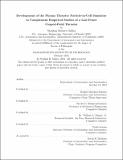Development of the plasma thruster particle-in-cell simulator to complement empirical studies of a low-power cusped-field thruster
Author(s)
Gildea, Stephen Robert
DownloadFull printable version (20.36Mb)
Other Contributors
Massachusetts Institute of Technology. Department of Aeronautics and Astronautics.
Advisor
Manuel Martínez-Sánchez.
Terms of use
Metadata
Show full item recordAbstract
Cusped-field plasma thrusters are an electric propulsion concept being investigated by several laboratories in the United States and Europe. This technology was implemented as a low-power prototype in 2007 to ascertain if durability and performance improvements over comparable Hall thruster designs could be provided by the distinct magnetic topologies inherent to these devices. The first device tested at low-powers was eventually designated the "diverging cusped- field thruster" (DCFT) and demonstrated performance capabilities similar to state-of-the-art Hall thrusters. The research presented herein is a continuation of these initial studies, geared toward identifying significant operational characteristics of the thruster using experiments and numerical simulations. After a review of hybrid, fluid, and particle-in-cell Hall thruster models, experimental contributions from this work are presented. Anode current waveform measurements provide the first evidence of the distinct time-dependent characteristics of the two main modes of DCFT operation. The previously named "high-current" mode exhibits oscillation amplitudes several factors larger than mean current values, while magnitudes in "low-current" mode are at least a full order smaller. Results from a long-duration test, exceeding 200 hours of high-current mode operation, demonstrate lifetime-limiting erosion rates about 50% lower than those observed in comparable Hall thrusters. Concurrently, the plasma thruster particle-in-cell (PTpic) simulator was developed by upgrading numerous aspects of a preexisting Hall thruster model. Improvements in performance and accuracy have been achieved through modifications of the particle moving and electrostatic potential solving algorithms. Data from simulations representing both modes of operation are presented. In both cases, despite being unable to predict the correct location of the main potential drop in the thruster chamber, the model successfully reproduces the hollow conical jet of fast ions in the near plume region. The influences guiding the formation of the simulated beam in low-current mode are described in detail. A module for predicting erosion rates on dielectric surfaces has also been incorporated into PTpic and applied to simulations of both DCFT operational modes. Two data sets from highcurrent mode simulations successfully reproduce elevated erosion profiles in each of the three magnetic ring-cusps present in the DCFT. Discrepancies between the simulated and experimental data do exist, however, and are once again attributable to the misplacement of the primary acceleration region of the thruster. Having successfully captured the most significant erosion profile features observed in high-current mode, a simulation of erosion in low-current mode indicates substantially reduced erosion in comparison to the more oscillatory mode. These findings further motivate the completion of low-current mode erosion measurements, and continued numerical studies of the DCFT. Additionally, PTpic has proven to be a useful simulation tool for this project, and has been developed with adaptability in mind to facilitate its application to a variety of thruster designs -- including Hall thrusters.
Description
Thesis (Ph. D.)--Massachusetts Institute of Technology, Dept. of Aeronautics and Astronautics, February 2013. This electronic version was submitted and approved by the author's academic department as part of an electronic thesis pilot project. The certified thesis is available in the Institute Archives and Special Collections. Cataloged from department-submitted PDF version of thesis. Includes bibliographical references (p. 273-285).
Date issued
2013Department
Massachusetts Institute of Technology. Department of Aeronautics and AstronauticsPublisher
Massachusetts Institute of Technology
Keywords
Aeronautics and Astronautics.